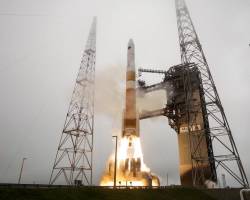The U.S. Air Force’s 2nd Space Operations Squadron (2SOPS) at the 50th Space Wing, Schriever Air Force Base, Colorado, has moved the longest-serving GPS satellite, space vehicle number (SVN) 23, into a disposal orbit several hundred miles above the operational GPS constellation.
The satellite, which was launched on November 26, 1990, had a rough start, the Air Force said. After early-orbit operations and initial stabilization in December 1990, SVN 23’s solar array stopped working.
The U.S. Air Force’s 2nd Space Operations Squadron (2SOPS) at the 50th Space Wing, Schriever Air Force Base, Colorado, has moved the longest-serving GPS satellite, space vehicle number (SVN) 23, into a disposal orbit several hundred miles above the operational GPS constellation.
The satellite, which was launched on November 26, 1990, had a rough start, the Air Force said. After early-orbit operations and initial stabilization in December 1990, SVN 23’s solar array stopped working.
“The latent defect became apparent quite quickly after we had placed it into operations. The solar array stopped tracking the sun,” said Frank Czopek, former program manager for Boeing’s GPS Block II/IIA support contract. “It had essentially blown a fused in the auto track mode. The GPS program had to replace the fused with a ground-controlled circuit breaker on all the remaining Block IIA satellites.”
After realizing the satellite had a design flaw, and that the ability to dispose of it would be endangered, the operators failed to power the solar array back on. The team had to switch the solar array’s mode to the second drive motor to save the satellite, the Air Force said.
For the next 14 years, in a technique called scissoring, Air Force crews and contractors manually commanded the solar arrays to move back and forth during orbit dawn and dusk, the Air Force said. More than 11 years ago, a decision was made to allow normal operations on the B side of the solar array drive, which the Air Force said “miraculously” allowed the satellite to work for its remaining 11 years of life.
“The difficulty was caused by the crews having to manual-position the arrays on a frequently basis. This went on for 15 years or so until some crew commanded auto-track function enable,” Czopek said. “It took many months to discover the arrays were tracking the sun, and since it was operating nominally, they decided to leave it in auto-track mode.”
As Inside GNSS reported earlier this year, SVN 23, the last operational GPS Block IIA satellite, was involved in two major anomalies in late January as the Air Force decommissioned the satellite. One was systemic and the other delayed the launch of the final Block IIF satellite.
Further investigation revealed an issue in the GPS ground software that affected the time on legacy L-band signals. This glitch appeared when SVN 23 was removed from the constellation.
The problem stemmed from an erroneous software upload as SVN 23 was taken offline. Fifteen operational GPS satellites reportedly were affected by the flaw.
Although SVN 23 had a long life, and much of its time was marred by technical difficulty, it wasn’t the worst Block IIA satellite, Czopek said. “SVN 23 was difficult, but the ‘bad boy’ of the Block IIAs is SVN 28 — whose navigation payload ceased to function at four-and-a-half years, which was less than the contractual requirement of six years,” he said.
SVN 28’s failure triggered the first space accident investigation board done by the 50th Space Wing, Czopek said. “There is a tie for runner-up between SVN 29 and SVN 33. SVN 29 ignored ground commands to stay in the same spot; so, it was allowed to wander in its orbital plane until it was disposed.
As for SVN 33, the valve that connected the two tanks on the spacecraft failed; so, propellant would not equalize during thruster firings.
“When the disposal was carried out, a wobble developed because of the failed valve. It was difficult to get both [satellites] into disposal orbits; so, my hat goes off to the crew and the contractor for getting them out of the way,” Czopek said.
Space Junk Continues to be Hot Issue
SVN 23 joins more than 2,000 satellites, both active and decommissioned, currently orbiting the planet. Many times that amount are characterized as space debris.
Concerns have been expressed in recent years by organizations that have studied the possibility of GNSS satellites, particularly those that have been “parked” in disposal or graveyard orbits, to drift and possibly collide with one another.
GPS satellites orbit at an altitude of approximately 12,600 miles (20,200 kilometers); Russia’s GLONASS SVs, at 11,842 miles (19,100 kilometers); Galileo 14,397 miles (23,222 kilometers); and Compass, 13,113 miles (21,150 kilometers). Moreover, because of their system design, GNSS spacecraft transmit their orbital positions (ephemerides) as part of their navigation messages.
Decommissioned satellites are switched off and placed into a disposal orbit higher than the operational constellation. Such out-of-service GPS satellites as SVN 23, for instance, are boosted about 500 kilometers (310 miles) further out into space.
In studies for the Air Force early in this decade, Aerospace Corporation researcher Chia-Chun (George) Chao and colleagues predicted that GPS satellites placed in disposal orbits will eventually — in 20 to 40 years — drift down into the operating constellation. Besides intersecting the GPS constellation, these satellites eventually could pose a threat to operational satellites in low Earth and geosynchronous orbits, Chao said.
SVN 23 outlasted all of its predecessors — and even others launched after it. With the implementation of a new launch, anomaly resolution, and disposal operations system (LADO), operators with 2SOPS and the 19th Space Operations Squadron at Schriever successfully disposed of SVN 29 in November 2007.




